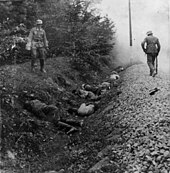This is an old revision of this page, as edited by Qwertyuio87tfvb (talk | contribs) at 00:36, 14 November 2024 (→Outline of the myth). The present address (URL) is a permanent link to this revision, which may differ significantly from the current revision.
Revision as of 00:36, 14 November 2024 by Qwertyuio87tfvb (talk | contribs) (→Outline of the myth)(diff) ← Previous revision | Latest revision (diff) | Newer revision → (diff) Aspect of World War II historiography


The myth of the clean Wehrmacht (German: Mythos der sauberen Wehrmacht) is the negationist notion that the regular German armed forces (the Wehrmacht) were not involved in the Holocaust or other war crimes during World War II. The myth, heavily promoted by German authors and military personnel after World War II, completely denies the culpability of the German military command in the planning and perpetration of war crimes. Even where the perpetration of war crimes and the waging of an extermination campaign, particularly in the Soviet Union – the populace of which was viewed by the Nazis as "sub-humans" ruled by "Jewish Bolshevik" conspirators – has been acknowledged, they are ascribed to the "Party soldiers corps", the Schutzstaffel (SS), but not the regular German military.
The myth began during the war, being promoted in the Wehrmacht's official propaganda and by soldiers of all ranks seeking to portray their institution in the best possible light; as prospects for victory faded, these soldiers began to portray themselves as victims. After Germany's defeat, the verdict of the International Military Tribunal (1945–1946), which released many of the accused, was misrepresented as exonerating the Wehrmacht. Franz Halder and other Wehrmacht leaders signed the Generals' memorandum entitled "The German Army from 1920 to 1945", which laid out the key elements of the myth, attempting to exculpate the Wehrmacht from war crimes.
The victorious Western Allies were becoming increasingly concerned with the growing Cold War against their former ally, the Soviet Union, and wanted West Germany to begin rearming to counter the perceived Soviet threat. In 1950, West German chancellor Konrad Adenauer and former officers met secretly at Himmerod Abbey to discuss West Germany's rearmament and agreed upon the Himmerod memorandum. This memorandum laid out the conditions under which West Germany would rearm: their war criminals must be released, the "defamation" of the German soldier must cease and foreign public opinion of the Wehrmacht must be raised. The Supreme Commander of NATO, U.S. General of the Army Dwight D. Eisenhower, having previously stated his belief that the "Wehrmacht and the "Hitler gang" (Nazi Party) were all the same", reversed this position and began to facilitate German rearmament in light of his deep concern over Soviet dominance of Eastern Europe. The British became reluctant to pursue further trials and released already-convicted criminals early.
As Adenauer courted the votes of veterans and enacted amnesty laws, Halder began working for the U.S. Army Historical Division. His role was to assemble and supervise former Wehrmacht officers to create a multi-volume operational account of the Eastern Front. He oversaw the writings of 700 former German officers and disseminated the myth through this network. Wehrmacht officers and generals produced exculpatory memoirs distorting the historical record. These writings proved enormously popular, especially the memoirs of Heinz Guderian and Erich von Manstein, and further disseminated the myth among a German public eager to cast off the shame of Nazism.
The year 1995 proved to be a turning point in German public consciousness. The Hamburg Institute for Social Research's Wehrmacht exhibition, which showed 1,380 graphic pictures of "ordinary" Wehrmacht troops complicit in war crimes, sparked a long-running public debate and reappraisal of the myth. Hannes Heer wrote that the war crimes had been covered up by scholars and former soldiers. German historian Wolfram Wette called the clean Wehrmacht thesis a "collective perjury". The wartime generation maintained the myth with vigour and determination. They suppressed information and manipulated government policy. After their passing, there was insufficient motive to maintain the deceit in which the Wehrmacht denied having been a full partner in the Nazis' industrialised genocide.
Outline of the myth
- Wette 2007, p. 269.
- Beorn 2014, pp. 12–17.
- Harrisville, David A. (2021). The Virtuous Wehrmacht: Crafting the Myth of the German Soldier on the Eastern Front, 1941-1944. Cornell University Press. pp. 12–13. ISBN 978-1-5017-6006-8.
- Plischke, Elmer (1983). "Foreign Relations of the United States, 1951, Volume III: European Security and the German Question. Part 1, Dept. of State Pub. 8982. Part 2, Dept. of State Pub. 9113. Washington: U.S. Govt. Printing Office, 1981. Pp. xxxiv, 2065. Index in part 2". American Journal of International Law. 77 (2): 446. doi:10.2307/2200893. ISSN 0002-9300. JSTOR 2200893 – via Cambridge University Press.
- Smelser & Davies 2008, p. 64.